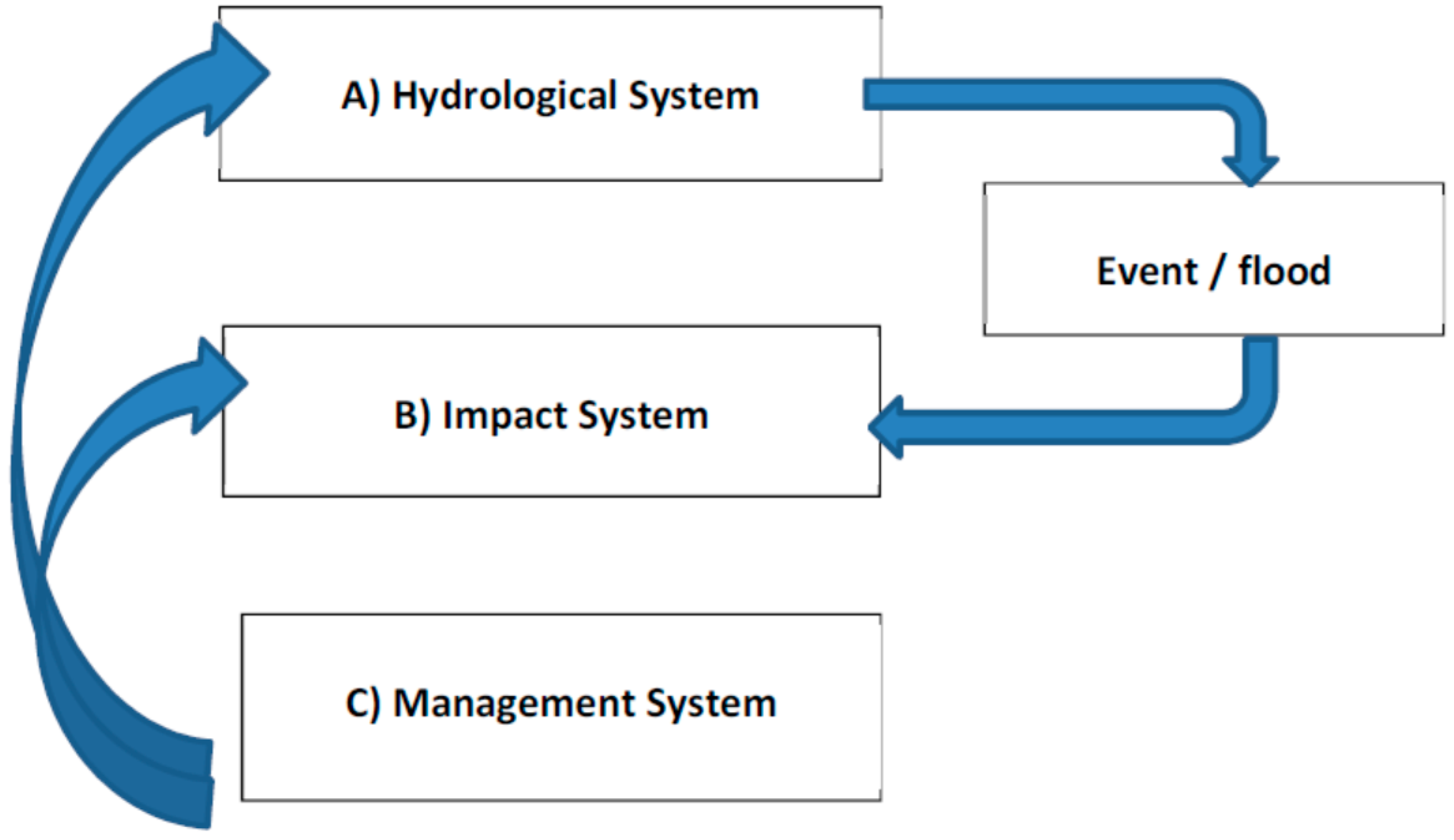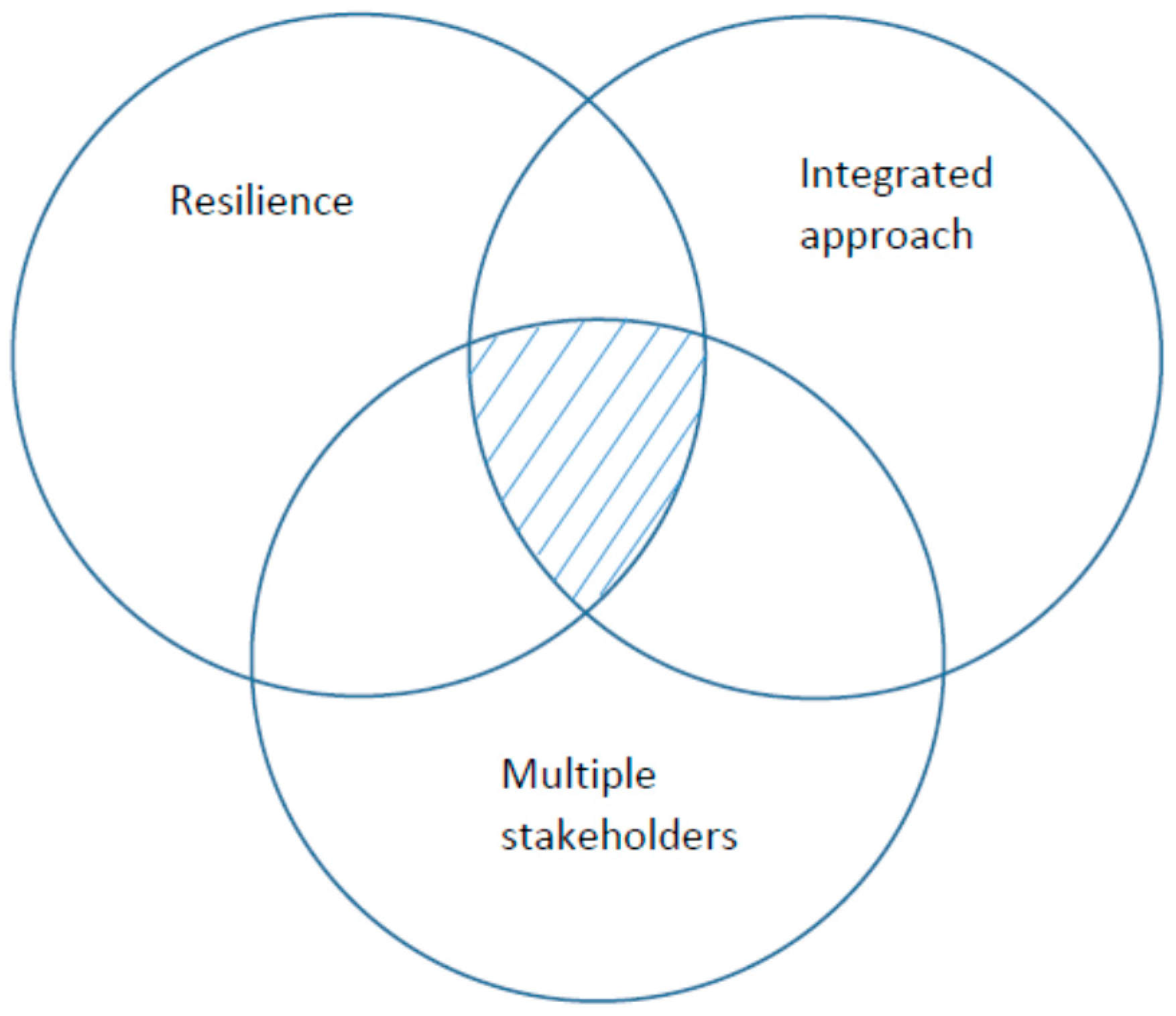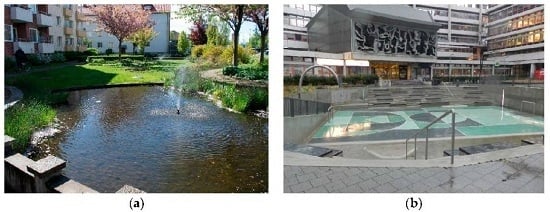Re-Thinking Urban Flood Management—Time for a Regime Shift
Abstract
:1. Introduction
2. Resilience in Flood Management
2.1. Concepts of Risk and Resilience
2.2. Flood Resilience
2.3. Time Perspective on Flood Management
2.4. Flood Management Strategies
3. Integrated Approach to Urban Planning and Design
3.1. Water Management beyond the Traditional Pipe System
3.2. Integrated Approaches to Flood Management
3.3. Importance of Planning for Sensitive Infrastructure
4. Flood Management with Multiple Stakeholders
4.1. Roles and Responsibilities
4.2. Multi-Stakeholder Planning
4.3. Information Sharing between Stakeholders
5. Discussion and Conclusions
- 1.
- Climate change and related impacts
- 2.
- Water, energy, land use, transportation, and socioeconomic nexus
- 3.
- Flexibility of different kinds of stormwater systems
- 4.
- Unresolved questions regarding responsibilities and improved communication between stakeholders and authorities.
- 5.
- Securing critical infrastructures
Acknowledgments
Author Contributions
Conflicts of Interest
References
- United Nations. World Urbanization Prospect; The Revision 2014. Highlights; UN: New York, NY, USA, 2014. [Google Scholar]
- Ligtvoet, W.; Hilderink, H.; Bouwman, A.; Puijenbroek, P.; Lucas, P.; Witmer, M. Towards a World of Cities in 2050. An Outlook on Water-Related Challenges; Background Report to the UN-Habitat Global Report; PBL Netherlands Environmental Assessment Agency: The Hague, The Netherlands, 2014. [Google Scholar]
- Remondia, F.; Burlando, P.; Vollmer, D. Exploring the hydrological impact of increasing urbanisation on a tropical river catchment of the metropolitan Jakarta, Indonesia. Sustain. Cities Soc. 2016, 20, 210–221. [Google Scholar] [CrossRef]
- Ståhle, A. Compact Sprawl: Exploring Public Open Space and Contradictions in Urban Density; School of Architecture, KTH: Stockholm, Sweden, 2008. [Google Scholar]
- Talen, E.; Ellis, C. Compact and diverse: The future of American urbanism. Hot, congested, crowded and diverse: Emerging research agendas in planning. Prog. Plan. 2009, 71, 153–205. [Google Scholar]
- Jongman, B.; Hochrainer-Stigler, S.; Feyen, L.; Aerts, J.C.J.H.; Mechler, R.; Botzen, W.J.W.; Bouwer, L.M.; Pflug, G.; Rojas, R.; Ward, P.J. Increasing stress on disaster-risk finance due to large floods. Nat. Clim. Chang. 2014, 4, 264–268. [Google Scholar] [CrossRef]
- Liao, K.-H. A theory on urban resilience to floods—A basis for alternative planning practices. Ecol. Soc. 2012, 17, 48. [Google Scholar] [CrossRef]
- Smits, A.J.M.; Nienhuis, P.H.; Saeijs, H.L.F. Changing estuaries, changing views. Hydrobiologia 2006, 565, 339–355. [Google Scholar] [CrossRef]
- Ashley, R.M.; Lundy, L.; Ward, S.; Shaffer, P.; Walker, L.; Morgan, C.; Saul, A. Water-sensitive urban design: Opportunities for the UK. Proc. Inst. Civ. Eng. Munic. Eng. 2013, 166, 65–76. [Google Scholar] [CrossRef]
- Brown, R.R.; Keath, N.; Wong, T.H.F. Urban water management in cities: Historical, current and future regimes. Water Sci. Technol. 2009, 59, 847–855. [Google Scholar] [CrossRef] [PubMed]
- Construction Industry Research and Information Association. CIRIA Research Project RP993. Demonstrating the Multiple Benefits of SuDS, a Business Case (Phase 2); Draft Literature Review; CIRIA: London, UK, 1 October 2013. [Google Scholar]
- Zhou, Q. A review of sustainable urban drainage systems considering the climate change and urbanization impacts. Water 2014, 6, 976–992. [Google Scholar] [CrossRef]
- Brown, R.R.; Farrelly, M.A. Delivering sustainable urban water management: A review of the hurdles we face. Water Sci. Technol. 2009, 59, 839–846. [Google Scholar] [CrossRef] [PubMed]
- Jones, L.M. Resilience by design: Bringing science to policy makers. Seismol. Res. Lett. 2015, 86, 294–301. [Google Scholar] [CrossRef]
- Willems, P.; Olsson, J.; Arnbjerg-Nielsen, K.; Beecham, S.; Pathirana, A.; Bulow Gregersen, I.; Madsen, H.; Nguyen, V.-T.-V. Impacts of Climate Change on Rainfall Extremes and Urban. Drainage Systems; IWA Publishing: London, UK, 2012. [Google Scholar]
- Aven, T.; Renn, O. On risk defined as an event where the outcome is uncertain. J. Risk Res. 2009, 12, 1–11. [Google Scholar] [CrossRef]
- Becker, P. Sustainability Science: Managing Risk and Resilience for Sustainable Development; Elsevier: Amsterdam, The Netherlands; Oxford, UK, 2014. [Google Scholar]
- Renn, O. The role of risk perception for risk management. Reliab. Eng. Syst. Saf. 1998, 59, 49–62. [Google Scholar] [CrossRef]
- Japp, K.P.; Kusche, I. Systems Theory and Risk. In Social Theories of Risk and Uncertainty: An Introduction; Zinn, J.O., Ed.; Blackwell Publishing: Malden, MA, USA; Oxford, UK, 2008; pp. 76–105. [Google Scholar]
- Zinn, J.O. Introduction. In Social Theories of Risk and Uncertainty: An Introduction; Zinn, J.O., Ed.; Blackwell Publishing: Malden, MA, USA; Oxford, UK, 2008; pp. 1–17. [Google Scholar]
- Renn, O. Risk Governance: Coping with Uncertainty in a Complex World; Earthscan: London, UK; Sterling, VA, USA, 2008. [Google Scholar]
- Slovic, P.; Fischhoff, B.; Lichtenstein, S. Why study risk perception? Risk Anal. 1982, 2, 83–93. [Google Scholar] [CrossRef]
- Kaplan, S.; Garrick, B.J. On the quantitative definition of risk. Risk Anal. 1981, 1, 11–27. [Google Scholar] [CrossRef]
- Luhmann, N. Social Systems; Stanford University Press: Stanford, CA, USA, 1995. [Google Scholar]
- Pimm, S.L. The complexity and stability of ecosystems. Nature 1984, 307, 321–326. [Google Scholar] [CrossRef]
- Cohen, L.; Pooley, J.A.; Ferguson, C.; Harms, C. Psychologists’ understandings of resilience: Implications for the discipline of psychology and psychology practice. Aust. Community Psychol. 2011, 23, 7–22. [Google Scholar]
- Holling, C.S. Resilience and stability of ecological systems. Ann. Rev. Ecol. Syst. 1973, 4, 1–23. [Google Scholar] [CrossRef]
- Berkes, F.; Folke, C. Linking social and ecological systems for resilience and sustainability. In Linking Social and Ecological Systems: Management Practices and Social Mechanisms for Building Resilience; Berkes, F., Folke, C., Eds.; Cambridge University Press: Cambridge, UK; New York, NY, USA, 1998. [Google Scholar]
- Pendall, R.; Foster, K.A.; Cowell, M. Resilience and regions: Building understanding of the metaphor. Camb. J. Reg. Econ. Soc. 2010, 3, 71–84. [Google Scholar] [CrossRef]
- Raworth, K. A Safe and Just Space for Humanity: Can We Live within the Doughnut? Oxfam: Oxford, UK, 2012. [Google Scholar]
- Van Leeuwen, C.J.; Koop, S.H.A.; Sjerps, R.M.A. City Blueprints: Baseline assessments of water management and climate change in 45 cities. Environ. Dev. Sustain. 2015, 1–16. [Google Scholar] [CrossRef]
- Mori, K.; Yamashita, T. Methodological framework of sustainability assessment in City Sustainability Index (CSI): A concept of constraint and maximisation indicators. Habitat Int. 2015, 45, 10–14. [Google Scholar] [CrossRef]
- European Environment Agency. Urban. Adaptation to Climate Change in Europe: Challenges and Opportunities for Cities Together with Supportive National and European Policies; EEA Report; European Environment Agency: Copenhagen, Denmark, 2012. [Google Scholar]
- Philip, R.; Anton, B.; van der Steen, P. SWITCH Training Kit. Integrated Urban Water Management in the City of the Future. Module 1. Strategic Planning, ICLEI, Freiburg, 2011. Available online: http://www.switchtraining.eu/ (accessed on 3 August 2016).
- Fryd, O.; Jensen, M.B.; Ingvertsen, S.T.; Jeppesen, J.; Magid, J. Doing the first loop of planning sustainable urban drainage system retrofits—A case study from Odense, Denmark. Urban Water J. 2010, 7, 367–378. [Google Scholar] [CrossRef]
- Payo, A.; Becker, P.; Otto, A.; Vervoort, J.; Kingsborough, A. Experiential lock-in: Characterizing avoidable maladaptation in infrastructure systems. J. Infrastruct. Syst. 2015, 1, 02515001. [Google Scholar] [CrossRef]
- European Parliament & European Council. Directive 2007/60/EC. Available online: http://ec.europa.eu/environment/water/flood_risk/ (accessed on 3 August 2016).
- Chocat, B.; Ashley, R.; Marsalek, J.; Matos, M.R.; Rauch, W.; Schilling, W.; Urbonas, B. Drainage-out-of-Sight-out-of-Mind? In Proceedings of the 5th International Conference Sustainable Techniques and Strategies in Urban Water Management, Lyon, France, 6–10 June 2004.
- Intergovernmental Panel on Climate Change (IPCC). Climate Change 2014: Impacts, Adaptation, and Vulnerability; IPCC Working Group II Contribution to AR5; Intergovernmental Panel on Climate Change: Geneva, Switzerland, 2014. [Google Scholar]
- RIBA Building Futures and ICE. Facing up to Rising Sea Levels, London, 2009. Available online: http://www.buildingfutures.org.uk/assets/downloads/Facing_Up_To_Rising_Sea_Levels.pdf (accessed on 3 August 2016).
- Cullberg, M.; Montin, S.; Tahvlizadeh, N. Urban Challenges, Policy and Action in Gothenburg—GAPS Project Baseline Study; Gothenburg, Sweden, 2014. [Google Scholar]
- Mathur, A.; da Cunha, D. SOAK: Mumbai in an Estuary; Rupa & Company: New Delhi, India, 2009. [Google Scholar]
- Swedish Civil Contingencies Agency (MSB). Pluvial Flooding; MSB: Karlstad, Sweden, 2013. (In Swedish) [Google Scholar]
- Finotti, A.R.; Susin, N.; Finkler, R.; Silva, M.D.; Schneider, V.E. Development of a monitoring network of water resources in urban areas as a support for municipal environmental management. WIT Trans. Ecol. Environ. 2014, 182, 133–143. [Google Scholar]
- Qin, H.P.; Li, Z.X.; Fu, G. The effects of low impact development on urban flooding under different rainfall characteristics. J. Environ. Manag. 2013, 129, 577585. [Google Scholar] [CrossRef] [PubMed] [Green Version]
- Abdellatif, M.; Atherton, W.; Alkhaddar, R. Assessing combined sewer overflows with long lead time for better surface water management. Int. J. Environ. Sci. Technol. 2014, 35, 568–580. [Google Scholar] [CrossRef] [PubMed]
- Shuster, W.D.; Bonta, J.; Thurston, H.; Warnemuende, E.; Smith, D.R. Impacts of impervious surface on watershed hydrology: A review. Urban Water J. 2005, 2, 263–275. [Google Scholar] [CrossRef]
- Geldof, G.D. The Three Points Approach. Key Note Speach at 2007 South Pacific Stormwater Conference. 2007. Available online: http://www.geldofcs.nl/pdf/Artikelen/NZWWA_STORMWATER_2007-_Paper_Govert_Geldof.pdf (accessed on 3 August 2016).
- Fratini, C.F.; Geldof, G.D.; Kluck, J.; Mikkelsen, P.S. Three Points Approach (3PA) for urban flood risk management: A tool to support climate change adaptation through transdisciplinarity and multifunctionality. Urban Water J. 2012, 9, 317–331. [Google Scholar] [CrossRef] [Green Version]
- Maimone, M. Philadelphia’s storm water and CSO programs: Putting green first. Proc. Water Environ. Fed. 2008, 6, 899–915. [Google Scholar] [CrossRef]
- Vanaskie, M.J.; Smullen, J.; Rajan, R.; Maimone, M.; Cammarata, M. Reducing pollutant loads from Philadelphia’s combined sewer system with green stormwater infrastructure. Proc. Water Environ. Fed. 2012, 5, 952–965. [Google Scholar] [CrossRef]
- Stovin, V.R.; Moore, S.L.; Wall, M.; Ashley, R.M. The potential to retrofit sustainable drainage systems to address combined sewer overflow discharges in the Thames Tideway catchment. Water Environ. J. 2013, 27, 216–228. [Google Scholar] [CrossRef]
- Maksimović, Č.; Kurian, M.; Ardakanian, R. Rethinking Infrastructure Design for Multi-Use Water Services; Springer Intern. Publ.: Dresden, Germany, 2015. [Google Scholar]
- Stahre, P. Blue-Green Fingerprints in the City of Malmö, Sweden—Malmö’s Way towards a Sustainable Urban Drainage; VA SYD: Malmö, Sweden, 2008. [Google Scholar]
- Hoyer, J.; Dickhaut, W.; Kronawitter, L.; Weber, B. Water Sensitive Urban Design; University of Hamburg: Hamburg, Germany, 2011. [Google Scholar]
- Buuren, A.; van Driessen, P.P.J.; Rijswick, H.F.M.W.; van Rietveld, P.; Salet, W.; Spit, T.J.M.; Teisman, G. Towards adaptive spatial planning for climate change: Balancing between robustness and flexibility. J. Eur. Environ. Plan. Law 2013, 10, 29–53. [Google Scholar] [CrossRef]
- Sörensen, J. SUDS solution tested during severe flood event. In Poster Presented at Achieving Blue Green Dream Project, Imperial College London, London, UK, 11 November 2015.
- Potz, H.; Bleuze, P. Urban Green-Blue Grids for Sustainable and Dynamic Cities; Coop for Life: Delft, The Netherlands, 2012. [Google Scholar]
- Cettner, A.; Söderholm, K.; Viklander, M. An adaptive stormwater culture? Historical perspectives on the status of stormwater within the Swedish urban water system. J. Urban Technol. 2012, 19, 1–17. [Google Scholar] [CrossRef]
- Thompson, S.; Kent, J. Healthy built environments supporting everyday occupations: Current thinking in urban planning. J. Occup. Sci. 2013, 21, 25–41. [Google Scholar] [CrossRef]
- Mottaghi, M.; Aspegren, H.; Jonsson, K. The necessity for re-thinking the way we plan our cities with the focus on Malmö (towards urban-planning based urban runoff management). J. Water Manag. Res. 2015, 71, 37–44. [Google Scholar]
- Rinaldi, S.M.; Peerenboom, J.P.; Kelly, T.K. Identifying, understanding, and analyzing critical infrastructure interdependencies. IEEE Control Syst. 2001, 21, 11–25. [Google Scholar] [CrossRef]
- Perrow, P. Normal Accidents. Living with High-Risk Technologies; Basic Books, Inc.: New York, NY, USA, 1984. [Google Scholar]
- Hills, A. Insidious environments: Creeping dependencies and urban vulnerabilities. J. Conting. Crisis Manag. 2005, 13, 12–21. [Google Scholar] [CrossRef]
- Johnson, C.W.; McLean, K. Tools for Local Critical Infrastructure Protection: Computational Support for Identifying Safety and Security Interdependencies between Local Critical Infrastructures. In Proceedings of the Third IET International Conference on Systems Safety, Birmingham, UK, 20–22 October 2008.
- Rajabi, M.R.; Mansourian, A.; Pilesjö, P.; Bazmany, A. Environmental modelling of visceral leishmaniasis by susceptibility-mapping using neural networks: A case study in north-western Iran. Geospat. Health 2014, 9, 179–191. [Google Scholar] [CrossRef] [PubMed]
- Lubida, A.; Veysipanah, M.; Pilesjö, P.; Mansourian, A. Land-use optimization for sustainable urban planning in Zanzibar. Trans. GIS 2016. under review. [Google Scholar]
- Coombes, P.J. Transitioning drainage into urban water cycle management. In Proceedings of the Hydrology and Water Resources Symposium, Sydney, Australia, 7–10 December 2015.
- Daniell, K.A.; Coombes, P.J.; White, I. Politics of innovation in multi-level water governance systems. J. Hydrol. 2014, 519, 2415–2435. [Google Scholar] [CrossRef]
- Mansourian, A.; Lubida, A.; Pilesjö, P.; Abdolmajidi, E.; Lassi, M. SDI planning using the system dynamics technique within a community of practice: Lessons learnt from Tanzania. Geo-Spat. Inf. Sci. 2015, 18, 9–10. [Google Scholar] [CrossRef]
- Osberghaus, D.; Dannenberg, A.; Mennel, T.; Sturm, B. The role of government in adaption to climate change. Environ. Plan. C Gov. Policy 2010, 28, 834–850. [Google Scholar] [CrossRef]
- Hovik, S.; Naustdalslid, J.; Reitan, M.; Muthanna, T. Adaption to climate change: Professional networks and reinforcing institutional environments. Environ. Plan. C Gov. Policy 2015, 33, 104–177. [Google Scholar] [CrossRef]
- Thaler, T.; Priest, S. Partnership funding in flood risk management: New localism debate and policy in England. Area 2014, 46, 418–425. [Google Scholar] [CrossRef]
- Environment Agency. Defra Principles for Implementing Flood and Coastal Resilience Funding Partnership; Environment Agency: Bristol, UK, 2010. [Google Scholar]
- Walker, J.; Cooper, M. Genealogies of resilience: From systems ecology to the political economy of crisis adaptation. Secur. Dialogue 2011, 42, 143–160. [Google Scholar] [CrossRef]
- Hornborg, A. Revelations of resilience: From the ideological disarmament of disaster to the revolutionary implications of (p) anarchy. Resilience 2013, 1, 116–129. [Google Scholar] [CrossRef]
- Joseph, J. Resilience as embedded neoliberalism: A governmentality approach. Resilience 2013, 1, 38–52. [Google Scholar] [CrossRef]
- Evers, M.; Jonoski, A.; Maksimović, Č.; Lange, L.; Ochoa Rodriguez, S.; Teklesadik, A.; Cortes Arevalo, J.; Almoradie, A.; Eduardo Simoes, N.; Wang, L.; et al. Collaborative modelling for active involvement of stakeholders in urban flood risk management. Nat. Hazards Earth Syst. Sci. 2012, 12, 2821–2842. [Google Scholar] [CrossRef]
- Garavan, T.N.; McCarthy, A. Collective learning processes and human resource development. Adv. Dev. Hum. Resour. 2008, 10, 451–471. [Google Scholar] [CrossRef]
- Wolthusen, S.D. GIS-based Command and Control Infrastructure for Critical Infrastructure Protection. In Proceedings of the 2005 First IEEE International Workshop on Critical Infrastructure Protection (IWCIP’05), Atlanta, GA, USA, 3–4 November 2005.
- Diaz-Nieto, J.; Blanksby, J.; Lerner, D.N.; Saul, A.J. A GIS approach to explore urban flood risk management. In Proceedings of the 11th International Conference on Urban Drainage, Edinburgh, UK, 31 August–5 September 2008.
- Mansourian, A.; Rajabifard, A.; Valadan Zoej, M.J.; Williamson, I.P. Using SDI and web-based systems to facilitate disaster management. J. Comput. GeoSci. 2006, 32, 303–315. [Google Scholar] [CrossRef]
- Mansourian, A.; Abdolmajidi, E. Investigating the system dynamics technique for the modelling and simulation of the development of spatial data infrastructures. Int. J. Geogr. Inf. Sci. 2011, 25, 2001–2023. [Google Scholar] [CrossRef]
- Farnaghi, M.; Mansourian, A. Disaster planning using automated composition of semantic OGC web services: A case study in sheltering. Comput. Environ. Urban Syst. 2013, 41, 204–218. [Google Scholar] [CrossRef]
- Mansourian, A.; Taleai, M.; Fasihi, A. A Web-based spatial decision support system to enhance public participation in urban planning process. J. Spat. Sci. 2011, 56, 269–287. [Google Scholar] [CrossRef]
- Minne, E.A.; Crittenden, J.C.; Pandit, A.; Jeong, H.; James, J.; Zhongming, L.; Ming, X.; French, S.; Subrahmanyam, M.; Noonan, D.; et al. Water, energy, land use, transportation and socioeconomic nexus: A blue print for more sustainable urban systems. In Proceedings of the 2011 IEEE International Symposium Sustainable Systems and Technology (ISSST), Chicago, IL, USA, 16–18 May 2011; pp. 1–4. [CrossRef]





© 2016 by the authors; licensee MDPI, Basel, Switzerland. This article is an open access article distributed under the terms and conditions of the Creative Commons Attribution (CC-BY) license (http://creativecommons.org/licenses/by/4.0/).
Share and Cite
Sörensen, J.; Persson, A.; Sternudd, C.; Aspegren, H.; Nilsson, J.; Nordström, J.; Jönsson, K.; Mottaghi, M.; Becker, P.; Pilesjö, P.; et al. Re-Thinking Urban Flood Management—Time for a Regime Shift. Water 2016, 8, 332. https://doi.org/10.3390/w8080332
Sörensen J, Persson A, Sternudd C, Aspegren H, Nilsson J, Nordström J, Jönsson K, Mottaghi M, Becker P, Pilesjö P, et al. Re-Thinking Urban Flood Management—Time for a Regime Shift. Water. 2016; 8(8):332. https://doi.org/10.3390/w8080332
Chicago/Turabian StyleSörensen, Johanna, Andreas Persson, Catharina Sternudd, Henrik Aspegren, Jerry Nilsson, Jonas Nordström, Karin Jönsson, Misagh Mottaghi, Per Becker, Petter Pilesjö, and et al. 2016. "Re-Thinking Urban Flood Management—Time for a Regime Shift" Water 8, no. 8: 332. https://doi.org/10.3390/w8080332










